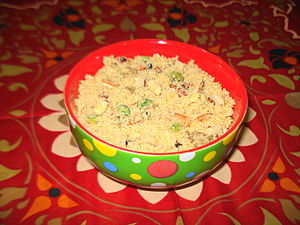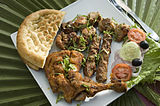Panjiri
 | |
| Alternative names | Kasaar[1] |
|---|---|
| Course | Dessert |
| Place of origin | Indian subcontinent |
| Main ingredients | Whole-wheat flour, sugar, ghee, dried fruits, herbal gums |
Panjiri is a North Indian dish which is made from whole-wheat flour fried in sugar and ghee, heavily laced with dried fruits and herbal gums.[2] It is eaten by women after giving birth[3] as a nutritional supplement, to promote healing and lactation, or eaten in general in the winters to ward off cold.[2] Its usage is culturally and traditionally meaningful.
It is consumed in North Indian states of Punjab,[4][5] Haryana,[6][7] Rajasthan,[8] Gujarat[9] Jammu,[10][11][12] Himachal Pradesh,[13] Bihar, and Uttar Pradesh.[14]
Etymology[]
The term panjīrī is ultimately from Sanskrit elements panch (five) and jīraka (cumin).[15] Panjiri is prepared by roasting wheat flour in Ghee and adding dry fruits and spices like Jeera (cumin), Dhaniya (coriander), Saunth (Dry Ginger powder) etc.
Other uses[]
Panjiri is popular across north India, and is often prepared as a Prasad in Hindu prayers during Krishna Janamashtami[16][17][18][19][20][21] and Satyanarayan Puja.[22][23]
Ingredients[]
- Atta (whole wheat flour) or sooji can also be used
- Ghee
- Chaar magaz (melon seeds)
- Sugar
- Almond
- Powdered edible gum crystals (gondh)
- Flame-of-the-forest (kamarkas)
- Fennel seeds (Saunf)
- puffed lotus seeds (makhane)
- carom seeds (ajwain)
- powdered cardamom seeds (elaichi)
- powdered dried ginger powder (saunth)
- walnut (akhrot)
- Figs (anjeer)
- unsalted pistachio nuts (pista)
- powdered sugar (boora)
Cooking method[]
- Heat 500 gm ghee in a heavy bottomed kadai.
- Fry all the dry fruits one by one till they turn golden brown, first almonds, then cashew nuts, walnuts, pistachio nuts, lotus seeds, and lastly, melon seeds. Keep them aside.
- In the same ghee, fry the kamarkas, and keep them aside as well.
- Next, roast the grated coconut and keep it aside.
- Now, coarsely grind all the fried dry fruits, except the melon seeds. Mix the dry fruits, roasted coconut and melon seeds together in a large pan and keep aside. Grind the kamarkas into fine powder and keep them aside as well.
- Heat the remaining ghee and roast flour over medium heat till the colour of the flour changes to golden brown and the ghee starts separating.
- Turn down the flame at this point and sprinkle in powdered gum crystals. Keep stirring the mixture until the crystals puff up and the spluttering stops.
- Add the powdered saunth and ajwain to the roasted flour and stir the whole mixture until all the ingredients are well blended.
- Turn off the flame. Keep on stirring the mixture for another 5–10 minutes.
- Now add the dry fruits, magaz, sugar and kamarkas to the roasted flour and mix well. Transfer the mixture to a large dish or tray and let cool.
- Store the mixture in an airtight container.
See also[]
- Satyanarayan Puja
- Krishna Janamashtami
- North Indian Cuisine
- Indian cuisine
References[]
- ^ Bahri, Hardev (2 August 2021). Rajpal Hindi Shabdkosh. ISBN 9788170280866.
- ^ a b O'Brien, Charmaine (2013). The Penguin Food Guide to India. New York: Penguin Books Limited. p. 32. ISBN 9789351185758.
Panjiri is a Punjabi sweet made of wheat flour or semolina cooked in ghee to which sugar, dried fruits, and natural gum are added.... These are eaten during winter to ward off cold weather ills and also given to women who are breastfeeding.
- ^ Crooke, William (1888). A Rural and Agricultural Glossary for the N.W. Provinces and Oudh. Calcutta: Superintendent of Government Printing. p. 218. ISBN 9788185326009.
- ^ Devalla, Rani (July 22, 2013). "Traditional Punjabi dish for pregnant women". thehindu.com.
A generous amount of almonds, walnuts, pistachios, dry dates, cashew nuts along with whole wheat flour, sugar, edible gum (khanewala gondh), poppy seeds and fennel seeds (saunf) get into the traditional dish of Punjabis 'panjiri'...
- ^ Verma, Abhinav. "Culinary nostalgia: Decoding the magic of pinni and panjiri, right out of grandma's kitchen". hindustantimes.com. Retrieved 3 June 2021.
Here’s an ode to the sweet classics, which have been the cornerstones of Punjab’s culinary history.
- ^ Haryana District Gazetteers: Ambala district gazetteer, 1883-84. Gazetteers Organisation, Revenue Department, Haryana. 1998.
- ^ Singh, K. S. (1994). Haryana. Anthropological Survey of India by Manohar Publishers. ISBN 978-81-7304-091-7.
- ^ लाल़स, सीतारांम (1962). राजस्थांनी सबद कोस: राजस्थानी हिन्दी बृहत् कोश (in Hindi). Rājāsthānī Śodha Saṃsthāna.
- ^ Cultures, Institute of Traditional (1966). Bulletin of the Institute of Traditional Cultures, Madras. University of Madras.
- ^ "Cuisine of Jammu". www.jktdc.co.in. Retrieved 2021-08-02.
- ^ "CUISINE OF DOGRAS OF JAMMU: A PERFECT EMBODIMENT OF SATTAVIC AND RAJASIC QUALITIES". JK News Today. 2016-10-11. Retrieved 2021-08-02.
- ^ Singh, K. S.; Pandita, K. N.; Charak, Sukh Dev Singh; Rizvi, Baqr Raza; India, Anthropological Survey of (2003). Jammu & Kashmir. Anthropological Survey of India. ISBN 978-81-7304-118-1.
- ^ Borah, Jahnabee (2020-08-29). "Why Himachali cuisine is having a moment". mint. Retrieved 2021-08-02.
- ^ Varmā, Bimalā (1987). Uttara Pradeśa kī lokakalā: bhūmi aura bhitti alaṅkaraṇa (in Hindi). Jayaśrī Prakāśana.
- ^ Varmā, Rāmacandra (1971). Saṅkshipta Hindī śabdasāgara (in Hindi). Nāgarīpracāriṇī Sabhā.
- ^ Rājasthānī-Hindī kahāvata-kośa: Aṃ se kā taka kahāvateṃ (in Hindi). Rājasthānī Granthāgāra. 2003.
- ^ Chandra, Sharad (2001). To kyā? (in Hindi). Neśanala Pabliśiṅga Hāusa. ISBN 978-81-214-0468-6.
- ^ Indian Literature. Sahitya Akademi. 2006.
- ^ "Easy traditional Panjiri recipes for Janmashtami". The Times of India. 2020-08-11. Retrieved 2021-08-02.
- ^ "Janmashthmi 2020: Why is Panjiri so popular in Janmashtmi?". The Times of India. 2020-08-09. Retrieved 2021-08-02.
- ^ Desk, India TV News (2019-08-22). "Janmashtami 2019: Special traditional dishes and desserts to offer on Lord Krishna's birthday". www.indiatvnews.com. Retrieved 2021-08-02.
- ^ Pandey, Indu Prakash (1977). Avadhī kahāvateṃ (in Hindi). Racanā Prakāśana.
- ^ Sadaiv, Shashikant (101-01-01). Vrat-Upvas Ke Dharmik Aur Vaigyanik Adhar (in Hindi). Prabhat Prakashan. ISBN 978-93-87980-55-6.
{{cite book}}: Check date values in:|date=(help)
- Indian desserts
- Punjabi cuisine



